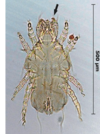Ectoparasites Flashcards
(12 cards)
1
Q
- Identify this parasite
- Describe its appearance
- Clinical Signs?
- Life Cycle?
- Zoonotic? Y/N?
- Leg number in adults?

A
- Sarcoptes Scabei
- Round to oval shape
Legs with pedicles or stalks at the end
Pedicles might be long or short, jointed or unjointed - EXTREME PRURITIS + dermatitis. Itchy ears, ventrum, elbows, legs
- 4 cycle spent entirely on the host.
Males and females breed on the skin->penetrate the keratin layers of the skin->burrow through the epidermis->10-15d later she has laid about 50 eggs which emerge b/t 3-10days-they molt and become nymphs-> then they mature and in about 2 weeks it starts all over again. Once the female has deposited her eggs , she dies, so that is all she is good for
- yes
- 8
2
Q
- Name this parasite
- Describe egg and adult appearance
- Is it zoonotic?
- Where is it commonly found?
- Life Cycle?
- Clinical Signs?
- Which species commonely affected?

A
- Demodex
- spindle-shaped egg, long adults with stubby legs
- No
- Hair follicles and sebaceous glands
- 5 stage life cycle
- Patchy alopecia on the muzzle, face, and forelimbs
- Dog
3
Q
- Name this parasite
- Describe appearance
- Species affected?
- Commonly found in what areas?
- Life cycle?
- Clinical sign?

A
- Notoedres cati
- Long unjointed pedicle with a sucker
- Cats and rabbits
- face, back of neck, ears, feet
- like scabies
- yellow crust
4
Q
- Name this parasite
- Also called
- Describe appearance
- Species affected?
- Clinical sign?
6.

A
- Chorioptes
- Foot, Tail, Itchy Leg Mite
- short unjointed pedicles with suckers on some of the legs
- large animals and ruminants
- serum exudate at the site; almost pus-like
5
Q
- Name this parasite
- What condition does it cause?
- Areas affected?
- What do you see at the site?
- Possible Signs?

A
- Cnemidocoptes pilae
- Scaly leg in budgies (pet parakeet)
- epidermis of the pads and feet
- honeycomb-like mass
- Irritable, one leg up and one leg down
6
Q
- Name this
- also called
- species affected?
- area affected
- appearance
- Dx

A
- Psoroptes cuniculi
- Ear Canker Mite of rabbits
- rabbits
- external ear canal
- dried cornflakes; long jointed pedicles with suckers
- Ear cytology
7
Q
- Name this
- AKA
- Species Affected
- Area affected
- Condition Caused
- Appearance
- Dx

A
- Ododectes Cynotis
- Ear Mite
- Rabbits and cats
- Tail Head Ear
- Otitis Externa
- Short unjointed pedicles with suckers
- Otoscopic exam; ear cytology
- Direct contact spread; highly transmissible
8
Q
- Name this parasite
- AKA
- Appearance
- How transferred?
- Area Affected
- Clinical Signs

A
- Cheyletiella
- Walking Dandruff
- Has palpal claws like a lobster
- Direct contact or fomites (inanimate objects that can transmit disease)
- Fur and keratin layer of dermis
- Dermatitis (dry and scaly), alopecia, hyperpigmentation
9
Q
- Identify this tick
- Which are the parasitic stages?
- Where is it found (geographically)?
- Where is it found on the body?
- Species affected?
- Dx?

A
- Otobius megnini (Spinose Ear Tick)
- Larval and Nymphal
- SW United States
- Deep in ear canal
- Herbivores and dogs
- Otoscope, examining waxy buildup
10
Q
- Identify this tick
- Species affected?
- Times of day preferred
- Appearance
- Clinical Sign

A
- Argas persicus aka Fowl Tick
- Chickens, turkeys, and wild birds
- nocturnal
- reddish brown normally and engorged (and blue!) after feeding
- anemia
11
Q
- Name
- Host
- Capitulum shape
- Engorged female appearance
- Clinical Signs
- Intermediate Host for…
- Diagnosis

A
- Brown Dog Tick or Rhipicephalus sanguineus
- Dog
- hexagonal
- grey
- Severe blood loss
- Babesia Canis
- Inornate brown color and basis capitulum with lateral projections
12
Q
- Name this tick
- Geographical location
- Hosts
- Vector for…
- Causes
- Appearance
- Engorged female appearance
- Dx

A
- American Dog or Wood Tick; Dermacentor variabilis
- Eastern US
- Humans, dogs, and rodents
- Rocky Mountain Spotted Fever
- Tick Paralysis
- Ornate scutum with white striping
- Blue-grey
- Morphology, rectangular base capitulum, white markings


